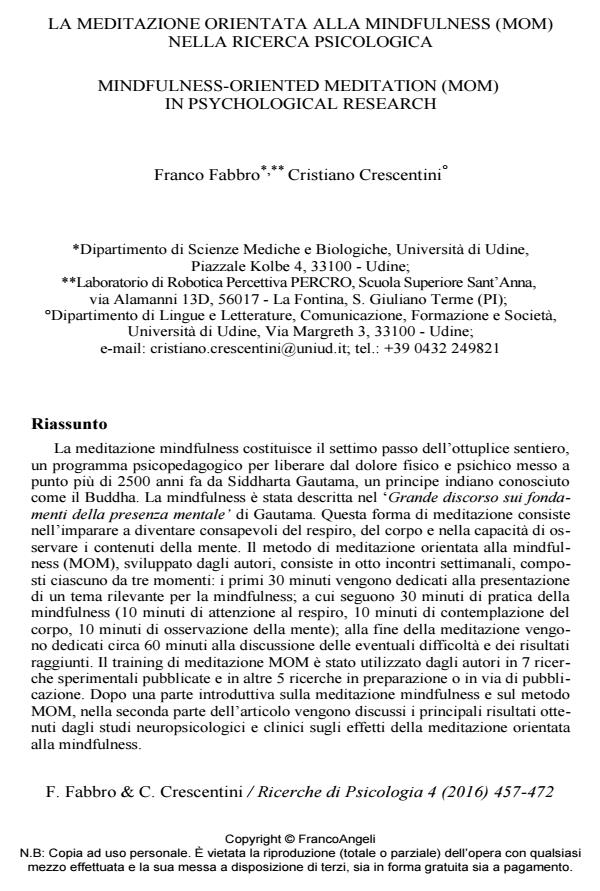La meditazione orientata alla mindfulness (mom) nella ricerca psicologica
Titolo Rivista RICERCHE DI PSICOLOGIA
Autori/Curatori Franco Fabbro, Cristiano Crescentini
Anno di pubblicazione 2017 Fascicolo 2016/4
Lingua Italiano Numero pagine 16 P. 457-472 Dimensione file 195 KB
DOI 10.3280/RIP2016-004001
Il DOI è il codice a barre della proprietà intellettuale: per saperne di più
clicca qui
Qui sotto puoi vedere in anteprima la prima pagina di questo articolo.
Se questo articolo ti interessa, lo puoi acquistare (e scaricare in formato pdf) seguendo le facili indicazioni per acquistare il download credit. Acquista Download Credits per scaricare questo Articolo in formato PDF

FrancoAngeli è membro della Publishers International Linking Association, Inc (PILA)associazione indipendente e non profit per facilitare (attraverso i servizi tecnologici implementati da CrossRef.org) l’accesso degli studiosi ai contenuti digitali nelle pubblicazioni professionali e scientifiche
La meditazione mindfulness costituisce il settimo passo dell’ottuplice sentiero, un programma psicopedagogico per liberare dal dolore fisico e psichico messo a punto più di 2500 anni fa da Siddharta Gautama, un principe indiano conosciuto come il Buddha. La mindfulness è stata descritta nel ‘Grande discorso sui fondamenti della presenza mentale’ di Gautama. Questa forma di meditazione consiste nell’imparare a diventare consapevoli del respiro, del corpo e nella capacità di osservare i contenuti della mente. Il metodo di meditazione orientata alla mindfulness (MOM), sviluppato dagli autori, consiste in otto incontri settimanali, composti ciascuno da tre momenti: i primi 30 minuti vengono dedicati alla presentazione di un tema rilevante per la mindfulness; a cui seguono 30 minuti di pratica della mindfulness (10 minuti di attenzione al respiro, 10 minuti di contemplazione del corpo, 10 minuti di osservazione della mente); alla fine della meditazione vengono dedicati circa 60 minuti alla discussione delle eventuali difficoltà e dei risultati raggiunti. Il training di meditazione MOM è stato utilizzato dagli autori in 7 ricerche sperimentali pubblicate e in altre 5 ricerche in preparazione o in via di pubblicazione. Dopo una parte introduttiva sulla meditazione mindfulness e sul metodo MOM, nella seconda parte dell’articolo vengono discussi i principali risultati ottenuti dagli studi neuropsicologici e clinici sugli effetti della meditazione orientata alla mindfulness.
Parole chiave:Meditazione, mindfulness, neuropsicologia, psicopatologia
- Universal crisis psychoeducational interventions in schools: A scoping review Michele Capurso, Simona De Stasio, Benedetta Ragni, in School Psychology International /2022 pp.339
DOI: 10.1177/01430343221104986 - Effects of Mind-Body Interventions on Adolescents’ Cooperativeness and Emotional Symptoms Susanna Feruglio, Stefania Pascut, Alessio Matiz, Andrea Paschetto, Cristiano Crescentini, in Behavioral Sciences /2022 pp.33
DOI: 10.3390/bs12020033 - Temperament and Character Moderate the Effects of Mindfulness Training on Psychological and Professional Well-Being of School Teachers Alessio Matiz, Stefania Pascut, Franco Fabbro, Cristiano Crescentini, in Mindfulness /2025 pp.1376
DOI: 10.1007/s12671-025-02573-0 - Positive Impact of Mindfulness Meditation on Mental Health of Female Teachers during the COVID-19 Outbreak in Italy Alessio Matiz, Franco Fabbro, Andrea Paschetto, Damiano Cantone, Anselmo Roberto Paolone, Cristiano Crescentini, in International Journal of Environmental Research and Public Health /2020 pp.6450
DOI: 10.3390/ijerph17186450
Franco Fabbro, Cristiano Crescentini, La meditazione orientata alla mindfulness (mom) nella ricerca psicologica in "RICERCHE DI PSICOLOGIA " 4/2016, pp 457-472, DOI: 10.3280/RIP2016-004001